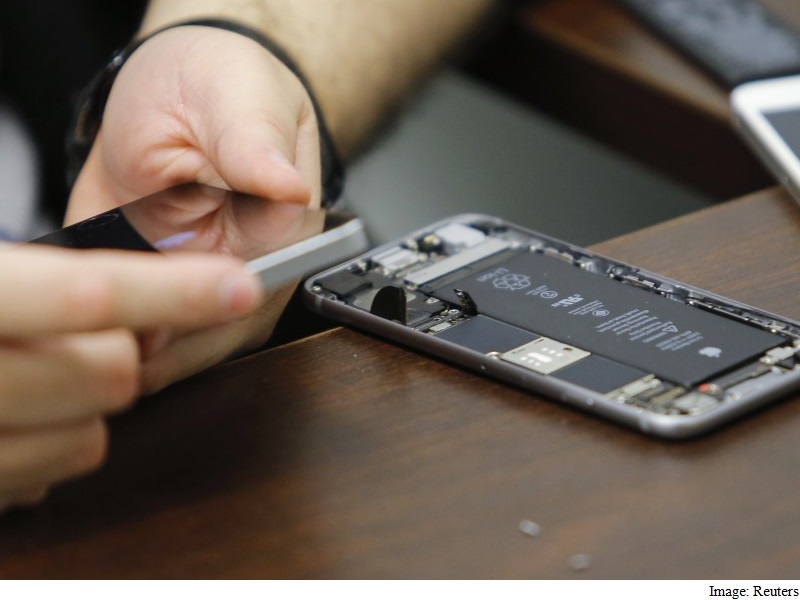
When Jessa Jones found out her kids had submerged her iPhone in her toilet, causing a clog, she thought her phone was a lost cause. It powered on but didn’t seem to be taking a charge anymore. The Apple store warns against water damage, which is not covered by warranty.
It wasn’t until Jones started poking around on online forums that the mother of four discovered that the phone didn’t charge because the charging chip was ruined. After two years of tinkering with the device, Jones finally got the phone to start working again.
“I didn’t want to abandon the phone just because it wouldn’t take a charge. It seemed like such a solvable problem,” she said.
She didn’t know that her journey to fix a phone would lead her to become one of the most innovativeiPhone repair experts in the game, and drive her to a world of black market electronics and leaked iPhone blueprints that spans the globe.
Jones is part of a group of independent device repair technicians who are dedicated to fixing and extracting data from damaged phones, tablets and computers. These fixers can rescue phone photos and prolong the life of the device. Yet their practice exists in a legal gray zone. Due to Apple’s tight grip on the repair services of its products, many repair technicians must rely on questionable electronic pieces from factories in China, as well as re-created design guides. The tech giant forbids official parts or device blueprints from being used outside of their Apple Genius bars or authorized third-party shops.
And Apple isn’t the only company with these strict repair guidelines. While Jones’s vocation is perfectly legal, she is sometimes forced to utilize not-quite-legitimate sources.
“For a cracked iPhone, the best quality screen that I can possibly source I’m technically not allowed to have,” said Jones. She risks confiscation every time she ships Apple parts from China, where she buys from sellers who could be sending her factory rejects, backdoor inventory or shoddy fakes, depending on her luck, she said. Then there are the design guides, or schematics, which she finds on unofficial websites and forums.
“It feels very much like we’re doing something wrong. It feels unsupported and illegitimate.”
A New York bill called the Fair Repair Act would help give Jones the legitimacy she desires. The bill requires that hardware manufacturers make repair instructions and parts available to the public. If passed by state lawmkers, the bill could open up independent access to repairs across the nation; its legality in one state would free up information and distribution flow to the rest of the country.
The impact of this right-to-repair legislation would extend beyond independent technicians like Jones. If the bill becomes law, it could be a big positive for the environment, cutting down on manufacturing costs and e-waste generated from disposed phones. That’s a major reason that New York state Sen. Phil Boyle decided to sponsor the bill, citing the destructive consumer cycle of buying new devices because minor repairs are too expensive to afford through official stores. These phones typically end up in landfills. Even recycling these devices properly relies on access to Apple device designs so that they can be easily disassembled and processed.
“The manufacturing impact of the electronic sector is huge,” said Kyle Wiens, a repair advocate and founder of iFixit, an online wiki of repair guides and electronic parts store. “If you’re gonna go to all the effort and environmental impact to make a phone, let’s make it last for seven or 10 years. And it’s okay if it’s not necessarily used by the first owner for all that long, but let’s make it so that somebody can use it.”
Studies have shown that the average American keeps their phone for around 1.5 to 2.5 years before moving on to a new one.
But New York’s right-to-repair legislation has made little progress toward passage. It’s still in its early stages of the state’s congress and will die if it isn’t passed by the end of the month. Documents in public government filings reviewed by the Huffington Post earlier this month show that Apple lobbied to kill the bill.
“Apple in particular has been really vocal about how environmentally friendly they are, but then, behind the scenes, they’re subverting every possible technique that people could have to make their products last longer,” said Wiens. Apple removed the iFixit app, created by Wiens’ repair community/company, from the app store last year when iFixit posted instructions on how to tear down the Apple TV.
Responding to questions from The Washington Post, Apple pointed to a company environmental report that demonstrates its e-waste efforts, including the development of a robot that helps take apart and recycle Apple products. The company also emphasized that it wants Apple devices to be repaired with genuine parts and verified technical know-how to preserve the integrity of the products. When pressed about Apple’s lobbying efforts to kill the bill, Apple declined to comment.
Wiens is also concerned that Apple’s tactics are quashing innovation. He uses Jones, the homemaker turned fixer guru, as an example. “She’s able to do much more sophisticated repairs than even Apple does,” he said. “There’s a huge amount of innovation that kind of starts at the grass-roots community. She’s hanging out on the online forums, starts tinkering, starts doing some of it on her own. And now she’s at the forefront of data recovery.”
Jones, who now owns her own corner repair shop in her hometown of Honeoye Falls, N.Y., hosts training courses to teach others how to extract vacation photos from a phone with water damage. She said that experts from well-known, well-established data recovery companies have shown up at her board repair course to learn her techniques.
Louis Rossmann, who owns a local electronic repair shop in Manhattan’s East Village, is another DIY fixer who turned his know-how into a small brick-and-mortar business. Rossmann, who didn’t go to college, has taught himself almost everything that he knows about electronics. His day typically consists of a flood of nearby New York University or New School students who have fried their computers and anxious that they won’t be able to access their notes or their thesis in time.
The Apple website is cagey in terms of what a fried motherboard would cost to repair, saying that it depends on the damage, but forums suggest around $750 to $1,000, not including shipping/handling. The cost is nearly the price of a new computer, and there’s no guarantee that the data will be saved.
Rossmann, who has been tinkering with computers for nine years, is able to repair the laptop and save the customer’s data for half the price. On his YouTube channel, which mixes detailed tutorials on device repair and motivational videos barked through a thick Staten Island accent, Rossmann advocates for right-to-repair laws.
“Think back to a time when the back panel of a television set had schematics and diagrams posted on it,” he said. “This was not thousands of years ago. This is how society was, but it was slowly taken away from us piece by piece over the last decade. This is important because we will eventually live in a world where everything is disposable if the precedent continues — where you do not own a device, you’re renting it until it breaks.”
In his videos, Rossmann focuses the camera on a motherboard, walking viewers step-by-step through the repairs. “I believe in the good that repair can do for society,” he said.
© 2016 The Washington Post











